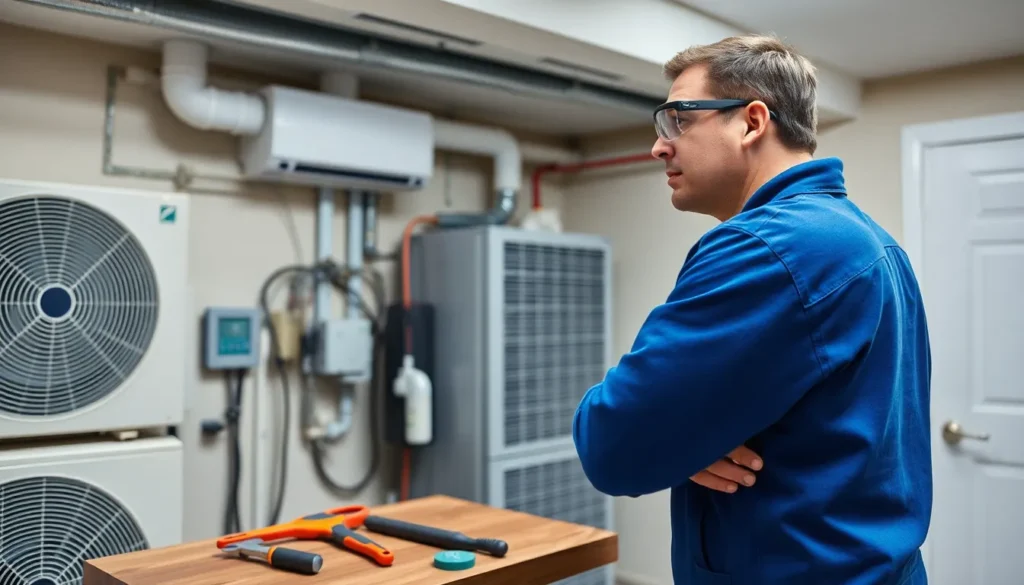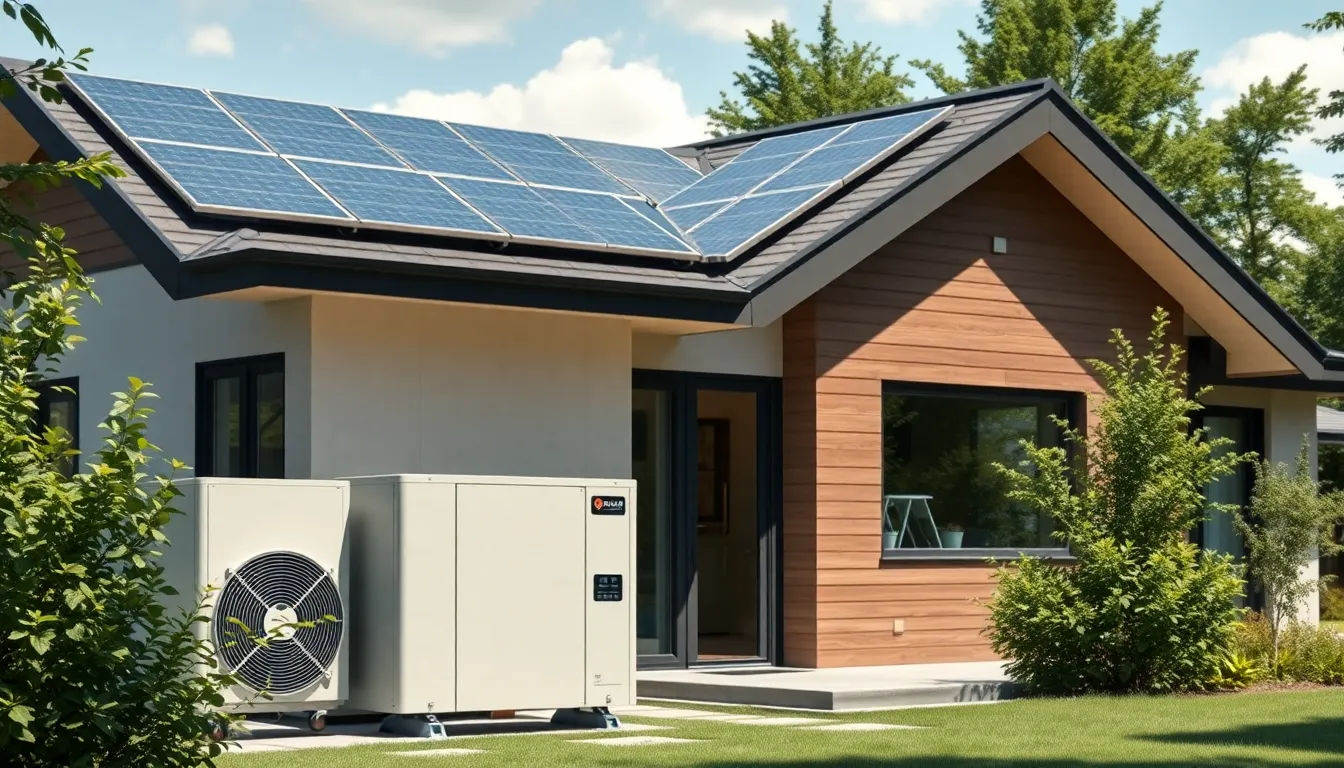In a world where energy bills can rival a small country’s GDP, sustainable HVAC systems are the superheroes we never knew we needed. They swoop in to save the day, keeping homes comfortable while also giving Mother Earth a much-deserved hug. Imagine a system that not only cools your summer but also warms your heart by reducing your carbon footprint. Sounds dreamy, right?
As climate change looms over us like a bad sequel, the push for greener technologies is more crucial than ever. Sustainable HVAC systems are the answer to the age-old question: how can we stay cozy while being kind to the planet? With innovative technology and eco-friendly practices, these systems don’t just keep the air fresh; they also make sure the future stays bright. So let’s dive into the world of sustainable HVAC and discover how it can transform both your home and the environment.
Table of Contents
ToggleOverview of Sustainable HVAC Systems
Sustainable HVAC systems play a crucial role in enhancing energy efficiency and minimizing environmental impact. These systems provide comfort while addressing energy costs and contributing to a healthier planet.
Definition and Importance
Sustainable HVAC systems are designed to maximize energy efficiency and reduce greenhouse gas emissions. They utilize technologies such as heat pumps and high-efficiency furnaces to create an eco-friendly climate control solution. The importance of these systems lies in their ability to lower energy bills while improving indoor air quality. Implementing sustainable HVAC solutions can lead to a significant reduction in carbon footprints. Homes equipped with these systems typically benefit from better thermal comfort and longevity of equipment. Transitioning to sustainable options proves essential for addressing ongoing environmental challenges.
Key Components
Several components define sustainable HVAC systems, each contributing to energy efficiency. Heat pumps serve as versatile devices, providing heating and cooling through minimal energy use. Energy recovery ventilators improve air quality by recovering energy from exhaust air. Insulation systems enhance efficiency by minimizing heat transfer, ensuring consistent indoor temperatures. Smart thermostats allow for precise temperature control, optimizing energy consumption. Advanced filtration systems, by removing allergens and pollutants, promote healthier indoor environments. Utilizing renewable energy sources, such as solar panels, supports the overall sustainability of these systems. Together, these components create a comprehensive approach to efficient climate control.
Benefits of Sustainable HVAC Systems
Sustainable HVAC systems offer numerous advantages, enhancing comfort while prioritizing environmental health. These systems stand out due to their energy efficiency and reduced environmental impact.
Energy Efficiency
Energy efficiency plays a crucial role in sustainable HVAC systems. They utilize advanced technologies like heat pumps and smart thermostats to optimize energy use. Homes equipped with these systems can experience up to 30% lower energy consumption compared to traditional units. Cost savings add to the appeal; lower energy bills result from reduced usage. Implementing energy recovery ventilators also improves system efficiency, capturing and reusing energy from indoor air. Overall, enhanced energy efficiency translates to immediate benefits for homeowners and long-term advantages for the environment.
Environmental Impact
Environmental impact remains a key consideration for sustainable HVAC systems. These systems significantly lower greenhouse gas emissions by utilizing renewable energy sources, such as solar panels. Factories emitting fewer pollutants typically enhance air quality, contributing to better health outcomes for occupants. Sustainable practices diminish the carbon footprint of buildings, making them more environmentally friendly. Additionally, incorporating advanced filtration systems ensures cleaner indoor air by trapping allergens and pollutants. By adopting sustainable HVAC solutions, both individuals and communities collectively reduce environmental harm while promoting sustainability.
Types of Sustainable HVAC Systems
Sustainable HVAC systems come in various forms, each designed to enhance energy efficiency and reduce environmental impact. Here are a few prominent types.
Geothermal Systems
Geothermal systems utilize the earth’s constant temperature to heat and cool spaces, providing reliable climate control. These systems consist of ground loops that exchange heat with the ground, thus offering superior efficiency. In optimal conditions, geothermal systems can reduce energy bills by 25% to 50% compared to conventional heating and cooling methods. Additionally, these systems have long lifespans, often lasting over 20 years with minimal maintenance. Adopting geothermal technology significantly lowers greenhouse gas emissions, helping combat climate change effectively.
Solar HVAC Systems
Solar HVAC systems capitalize on solar energy to power heating and cooling functions. By integrating solar panels, these systems harness sunlight to generate electricity or heat water, thereby providing a renewable energy source for HVAC needs. Solar HVAC systems can lead to energy bill reductions of up to 70% in some cases. They also encourage energy independence and resilience, especially in areas prone to power outages. Utilizing solar energy not only minimizes environmental impact but also enhances the overall sustainability of residential and commercial buildings.
Air Source Heat Pumps
Air source heat pumps extract heat from the air outside to warm interiors or expel heat for cooling. These systems operate efficiently even at low outdoor temperatures, offering energy savings of 30% to 50% compared to traditional HVAC systems. They also function as both heating and cooling solutions, providing year-round climate control. With advancements in technology, modern air source heat pumps can perform effectively in various climates, making them versatile options for homeowners. Implementing these systems can result in significant carbon footprint reductions, furthering the goal of sustainable living.
Implementation Strategies
Implementing sustainable HVAC systems requires careful planning and strategic decisions. Several factors contribute to the efficiency and effectiveness of these systems.
Design Considerations
Selecting the right design enhances energy efficiency. Incorporating passive solar design maximizes natural heating and cooling. Energy-efficient appliances play a vital role in overall system savings. Indoor air quality remains crucial; employing advanced filtration systems ensures clean air circulation. Given these aspects, collaboration with HVAC professionals ensures alignment with energy goals. Adapting designs based on local climate can further optimize energy performance.
Retrofitting Existing Systems
Many homeowners benefit from retrofitting existing HVAC systems to improve sustainability. Upgrading components like thermostats and air filters enhances efficiency without a complete system replacement. Sealing ductwork reduces energy loss, leading to significant savings. Insulating walls and attics prevents heat transfer, ensuring consistent indoor temperatures. Incorporating energy recovery ventilators recycles indoor air energy. Emphasizing these retrofitting strategies results in lower energy consumption and a reduced carbon footprint.
Challenges and Solutions
Sustainable HVAC systems face several challenges, yet practical solutions exist to overcome them.
Initial Costs
Initial costs often deter homeowners from investing in sustainable HVAC systems. Equipment like geothermal heat pumps can range from $10,000 to $25,000. Although this upfront expense is significant, long-term savings typically offset it. Energy bills can decrease by up to 30%, resulting in quicker return on investment. Incentives and rebates from government programs help alleviate some financial burdens. Additionally, financing options through manufacturers make these systems more accessible.
Maintenance and Operation
Ongoing maintenance and operation present additional challenges for sustainable HVAC systems. Regular inspections and servicing are crucial for optimal performance, which can require a knowledgeable technician. Increased complexity in system design may necessitate specialized training for maintenance personnel. Costs for routine upkeep could range from $100 to $300 annually, depending on the system type. Despite these considerations, many homeowners find that improved energy efficiency and reduced utility costs justify the maintenance investment. Emphasizing proper care ensures longevity and efficiency throughout the system’s lifespan.
Conclusion
Investing in sustainable HVAC systems is a smart choice for homeowners looking to enhance comfort while reducing their environmental impact. These systems offer significant energy savings and improved indoor air quality, making them a valuable addition to any home.
As technology continues to evolve, the potential for even greater efficiency and cost savings will only increase. By embracing sustainable HVAC solutions, individuals can contribute to a healthier planet and enjoy long-term financial benefits.
The shift towards sustainability in heating and cooling is not just a trend; it’s a necessary step toward a more energy-efficient future.










